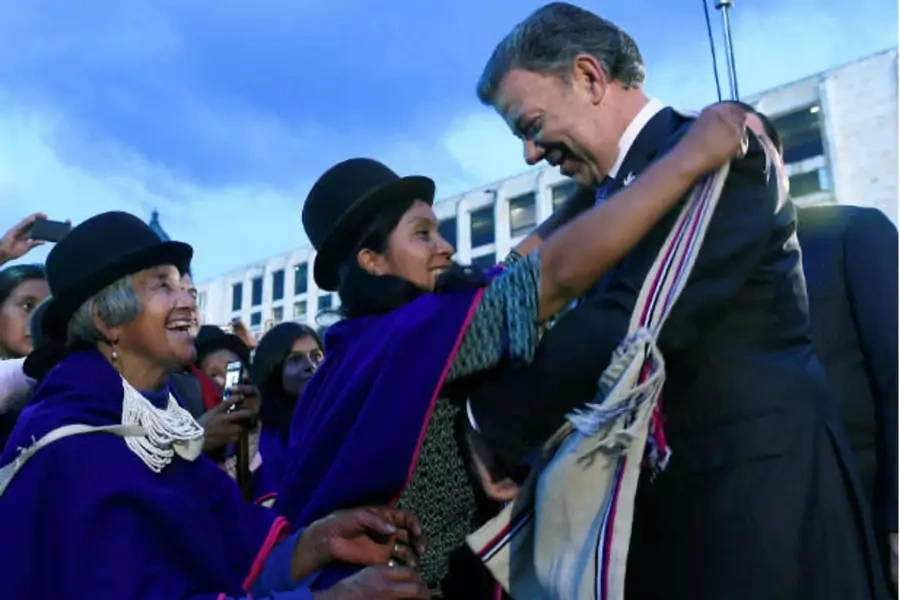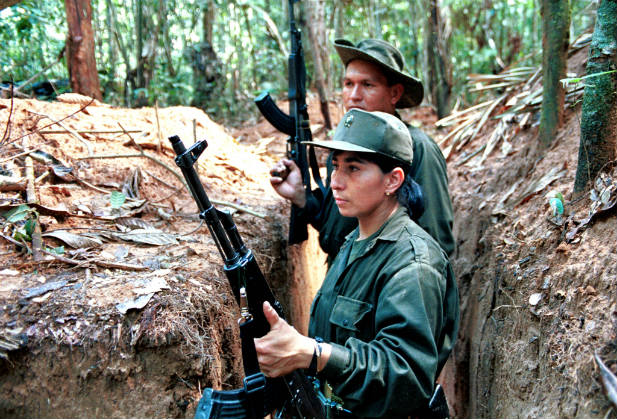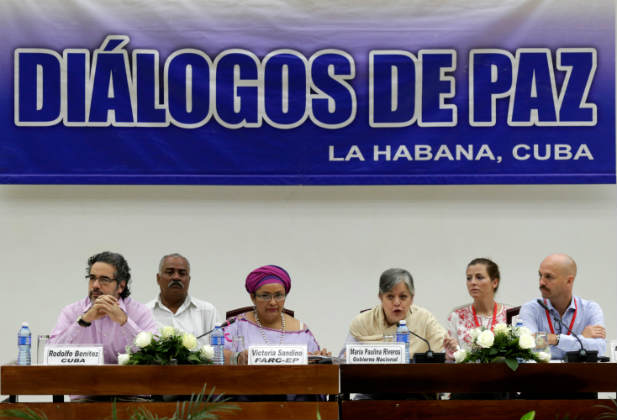Colombia’s Inclusive Peace Deal is at Risk

More on:
Voices from the Field features contributions from scholars and practitioners highlighting new research, thinking, and approaches to development challenges. This article is authored by Jacqueline O’Neill, director of the Institute for Inclusive Security, where she works with leaders in the United States and at the UN, NATO, and elsewhere around the world to increase the inclusion of women in peace and security processes.
When Colombian President Juan Manuel Santos awoke to news that he’d won the Nobel Peace Prize, he dedicated it to the millions of victims of Colombia’s fifty-two-year-long conflict.
He chose also to share it with the many who work for peace. That includes Colombian women who struggled to end the war and build just and enduring stability. As is often the case throughout the world, the role women played was not nearly as visible as men’s, but was no less significant.
Under Santos’ leadership, and because of collaboration between men and women on both sides of the negotiating table, Colombia reached an agreement that sets a global precedent for inclusion and political participation of historically marginalized groups, particularly women and LGBTI communities.
Their accomplishments are now at risk: opponents of the accord led a successful campaign encouraging the population to reject the agreement in last week’s referendum, and many are urging repeal of those inclusive provisions, promoting instead the concept of traditional “family values.”
The awarding of the Nobel Prize is an opportunity to reinforce elements that make Colombia’s achievements unique and to protect them from getting cut out of a potential revised peace deal. Time and again, global experiences prove that a failure to account for the marginalization of vulnerable groups as a driver of violent conflict—and to address it directly in peace agreements—can spell long-term disaster. Colombia is on the verge of getting it right, and can scarcely afford to sacrifice the very components that represent its strongest hope.

The Colombian people set precedents in crafting the process that led to the agreement, and in shaping the content of the deal itself.
During negotiations, parties heard direct testimony from victims of violence perpetuated by both sides. In possibly the first official intervention of its kind, victims—including thirty-six women who accounted for more than 60 percent of participants—described their trauma and pain, as well as their hopes for the future. In awarding the prize, the Nobel Committee emphasized the profound impression this testimony made. Observers note that it was women who kept the plight of the war’s victims—now addressed in detail in the accords—in the public eye.
The talks also included for the first time anywhere in the world a gender sub-commission established by negotiators from both sides. Members focused on how every issue on the main negotiating agenda might differently impact men, women, boys, and girls.
From a unique process came unique results. For the first time in such negotiations, the final agreement called for institutional actions to strengthen the political participation of LGBTI movements. It also called for guarantees for economic, social, and cultural rights for women and persons with diverse sexual identities.
Provisions relating specifically to women were no less extraordinary. The agreement called for equal access to rural property for women, and for the promotion of women’s participation in spaces of political representation, decision-making, and conflict resolution. The pact named prevention and protection measures to address specific risks faced by women. And, it called for access to truth and justice as well as measures against impunity—including not giving amnesty for crimes of sexual violence.

As U.S. Institute of Peace expert Virginia Bouvier notes, “[w]omen’s limited engagement at the table provides little sense of their tremendous contributions to the peace process. [They] were participants in secret exploratory talks between the government and the Revolutionary Armed Forces of Colombia (FARC) that produced the current negotiating agenda. In October 2013, a year after the peace talks were announced with a commitment to include under-represented groups, almost 450 women held a National Summit of Women and Peace in Bogota, Colombia’s capital, and demanded a place at the negotiating table for women.”
She noted that, two weeks later, President Santos named two women to the government’s team, accounting for one-fifth of government negotiators, while women made up 10 percent to 20 percent of FARC negotiators. Bouvier reported that women’s groups “have negotiated local ceasefires with armed groups and won the release of hostages. They have pressured insurgents to lifts roadblocks and documented human rights violations. Women have protested budget priorities of local governments and sought solutions to drug trafficking and other illegal activity.” In September, around five hundred women gathered again to celebrate the peace agreement and urge voters to support it.
Most Colombians are acutely aware that the hardest work of building peace is yet to come. The peace agreement is a roadmap, and the Nobel prize is a spark of hope for what is next. What must remain firmly in the minds of all involved is the pivotal role that women, Afro-Colombian, indigenous groups, and LGBTI communities will play in determining whether Colombian achieves peace or returns to devastating war. Making up about half of all country, and nearly 40 percent of the FARC fighters waiting to be demobilized and reintegrated into communities, women hold a big part of this fragile peace in their hands.
More on:
 Online Store
Online Store